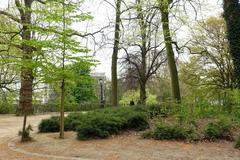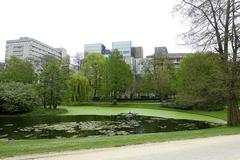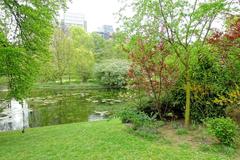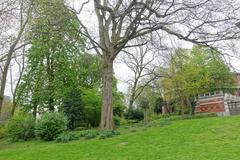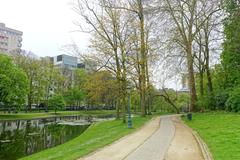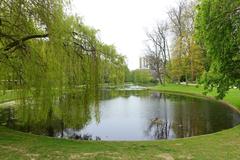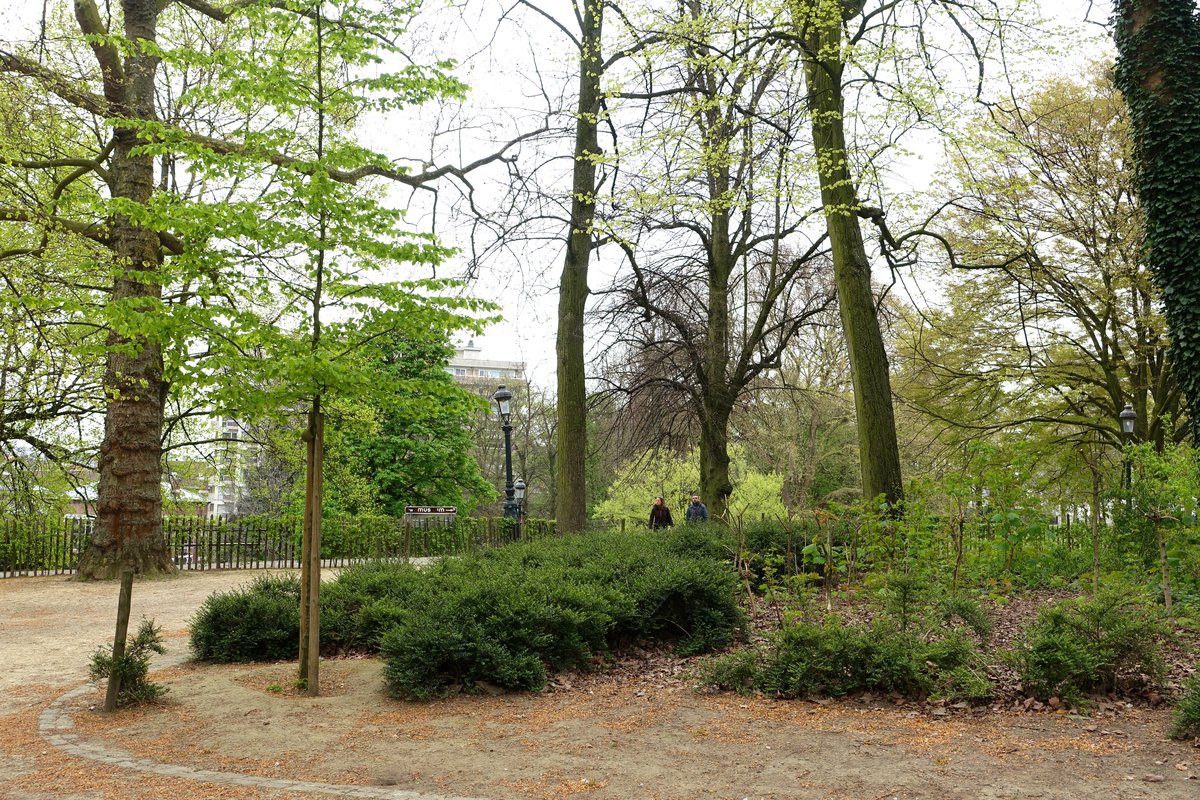
Leopold Park Brussels Visiting Hours, Tickets, and Travel Guide
Date: 14/06/2025
Introduction
Leopold Park is a 10-hectare haven of greenery and history in the heart of Brussels’ European Quarter. Established in the mid-19th century, the park offers a tranquil escape amidst the city’s urban landscape, while showcasing a rich past tied to scientific innovation and European culture. Visitors are drawn here by its lush scenery, architectural gems, and proximity to major European institutions. This comprehensive guide covers everything you need to know for an enjoyable visit, including opening hours, ticket information, attractions, accessibility, and travel tips.
For more details, refer to official sources such as visit.brussels and Wikipedia’s Leopold Park entry.
Contents
- Historical Overview
- Visitor Information
- Main Attractions and Park Features
- Practical Tips
- Frequently Asked Questions (FAQ)
- Visuals and Media
- Conclusion and Key Takeaways
- References
Historical Overview
From Zoological Garden to Public Park
Leopold Park’s origins lie in the Maelbeek valley and the Eggevoorde Estate. In 1851, the Société Royale de Zoologie et d’Horticulture de Bruxelles acquired the site, opening a zoological and botanical garden in 1853. Financial issues led to the zoo’s closure in 1876, but the horticultural gardens thrived under Jean Jules Linden. By the late 19th century, the city transformed the site into Brussels’ first landscaped public park, adopting the English garden style with meandering paths and a central pond (Wikipedia).
A Hub of Science and European Governance
Over time, the park became home to several scientific institutions, including the Solvay Institute of Sociology and Physiology, and the Eastman Dental Institute—now the House of European History. The arrival of the European Union’s institutions in the late 20th century brought renewed significance to the area, and Leopold Park became a symbol of Brussels’ role as the “capital of Europe” (Helen on Her Holidays).
Integration with the European Quarter
Leopold Park is central to the European Quarter’s identity, serving as a green oasis surrounded by EU offices, the European Parliament, and major museums. Public events, guided tours, and community days highlight the park’s ongoing cultural and civic role (visit.brussels).
Visitor Information
Visiting Hours
- April – September: 7:00 AM – 8:00 PM
- October – March: 7:00 AM – 6:00 PM
- Note: Hours may be adjusted on public holidays. Always check the official Brussels city website for updates.
Tickets and Admission
- Entry: Free of charge
- Guided Tours: Seasonal heritage and biodiversity walks are available and may require prior registration. Check with local guides or tourist offices for dates and availability.
Accessibility
- Paths: Most are paved and wheelchair accessible; some steeper areas may require assistance.
- Entrances: Main gates on Rue Belliard, Rue Wiertz, and Avenue de la Joyeuse Entrée.
- Facilities: Benches, rest areas, and accessible restrooms (in the Museum of Natural Sciences and nearby institutions).
- Public Transport:
- Metro: Maelbeek/Maalbeek and Schuman (lines 1 and 5)
- Bus: Multiple lines with stops nearby
- Rail: Brussels-Luxembourg station within walking distance
- Bicycle: Dedicated racks and bike lanes
Pets
- Dogs are welcome but must be kept on a leash. Owners are responsible for cleaning up after their pets.
Main Attractions and Park Features
Landscape and Nature
Leopold Park’s English-style landscape features rolling lawns, mature trees, and a central pond fed by the Maelbeek stream. The park supports diverse birdlife, including mallards, moorhens, coots, Egyptian geese, and rose-ringed parakeets (visitbenelux.net). Seasonal blooms and autumn foliage enhance its appeal year-round.
Architectural and Scientific Heritage
- Solvay Library: Originally part of the Solvay Business School, now hosts cultural events and conferences (visit.brussels).
- House of European History: Located in the renovated Eastman building, offers free exhibitions on European history.
- Royal Belgian Institute of Natural Sciences: Renowned for its dinosaur gallery and engaging family-friendly exhibits.
- Historic Institutes: Former Pasteur Institute, Anatomy and Physiology Institutes, many now serving as EU or regional offices.
Artworks and Memorials
- Bust of Jean-Jules Linden: Celebrates the Belgian botanist’s contributions.
- Tree of Peace: A symbolic monument for harmony and unity.
- Sculptures and Decorative Bridges: Reflect Brussels’ tradition of public art (smarksthespots.com).
Recreational Spaces
- Open lawns for picnics, yoga, and informal gatherings.
- Flat, stroller- and wheelchair-friendly paths ideal for walks and jogging.
- Playground for families with children.
Cultural Events
- Occasional open-air exhibitions, art shows, and guided walks (especially during Brussels’ heritage days and science festivals).
- The park is often a stop on historical and political walking tours (GPSmyCity).
Practical Tips
- Best Times to Visit: Spring and early autumn for flowers and foliage; weekdays are quieter.
- Food and Refreshments: No cafés inside the park, but plenty of options in the European Quarter nearby.
- Safety: Generally safe; keep belongings secure.
- Picnics: Allowed; open fires and barbecues are prohibited.
- Language: French, Dutch, and English are widely spoken; signage is bilingual.
Frequently Asked Questions (FAQ)
Q: What are Leopold Park’s opening hours?
A: 7:00 AM–8:00 PM (April–September), 7:00 AM–6:00 PM (October–March).
Q: Is there an entrance fee?
A: No, entry to Leopold Park is free.
Q: Are guided tours available?
A: Yes, seasonal heritage and biodiversity tours are available; check with local guides or visit.brussels.
Q: Is the park accessible for wheelchair users?
A: Yes, most paths are paved and accessible.
Q: Are pets allowed?
A: Dogs are allowed but must be kept on a leash.
Q: Can I picnic in the park?
A: Yes, but open fires and barbecues are not permitted.
Q: What public transport options are nearby?
A: Maelbeek/Maalbeek and Schuman metro stations; several bus and tram lines; Brussels-Luxembourg train station.
Visuals and Media
For images, maps, and interactive content, visit visit.brussels, smarksthespots.com, and Brussels Express. Alt tags such as “Leopold Park Brussels pond with swans” and “Solvay Library neoclassical building in Leopold Park” are recommended for accessibility.
Conclusion and Key Takeaways
Leopold Park is a living testament to Brussels’ commitment to green spaces, scientific achievement, and cultural diversity. Open daily with free admission, its lush landscapes, historic structures, and central location make it an essential stop for visitors to the European Quarter. Whether you’re seeking a peaceful stroll, architectural wonders, or educational experiences, Leopold Park offers a uniquely Brussels blend of nature and history.
For up-to-date information, travel tips, and interactive guides, download the Audiala app and follow us on social media. Enhance your Brussels journey and discover the tranquil heart of Europe at Leopold Park.
References
- Leopold Park, 2023, Wikipedia
- Brussels Parks and Forests, 2023, Visit.Brussels
- Visit the EU European Parliament in Brussels, 2023, Helen on Her Holidays
- Explore the History of Brussels Parks, 2023, Brussels Express
- Things to Do in Brussels, 2023, World Wild Schooling
- Leopold Park Brussels, 2023, VisitBenelux
- Leopold Park Brussels Visitor Guide, 2023, SmarksTheSpots
- European Quarter Public Space Strategy, 2023, Visit.Brussels
- Parc Leopold (Leopold Park) Walking Tours, 2023, GPSmyCity
